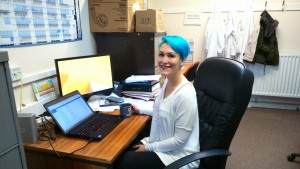My Experience at the European Association of Archaeologists (EAA) Conference, Glasgow 2015
Jessica Bownes BA(hons), MSc, PhD candidate.

Jessica Bownes BA(hons), MSc
PhD researcher at the Scottish Universities Environmental Research Centre
I joined the Scottish Universities Environmental Research Centre (SUERC), affiliated with the University of Glasgow, as part of their burgeoning cohort of PhD students in January 2014. The focus of my research is to unpick the problem of how human diet and our interaction with animals changed when the first farming communities emerged in Scotland around 6000 years ago. My work uses stable isotope measurements of ancient human and animal bone collagen, and of modern animal flesh and bone collagen to reconstruct the diet of these fascinating early farmers. I recently passed the halfway mark in my time with SUERC, and I’m beginning to get some really interesting results using a variety of novel scientific techniques. Having presented initial data at several conferences around the UK and Europe, I was delighted to receive a bursary from the Society to present my latest and most exciting findings at EAA Glasgow 2015.
My preparations for the conference were punctuated by an intensive week in the lab. There’s always a need for more data points! As I put together and practiced my presentation, I reflected on the sheer scale of the event I’d be attending. I was to join around 2000 other delegates from every corner of archaeological study. From analytical chemistry to archaeotourism, from Africa to outer space. There was a fantastic diversity in the different approaches used by academics to investigate a huge variety of aspects of lives and landscapes in the past. Alongside the sessions spread across the Glasgow campus were the opportunities to meet like-minded and influential people working in my field, at the gorgeous Oran Mor welcome party, at the Huntarian museum whisky tasting, and culminating in a fabulous dinner, very fittingly held at the Kelvingrove museum and art gallery.
For much of the conference I sought out sessions which were directly related to the scientific techniques I use (stable isotope analysis and radiocarbon dating), or the time period my research focuses on (the Mesolithic-Neolithic transition). At the first session I attended, Dr. Ricardo Fernandes’ ‘What Have Isotopes Done for Archaeology Lately?’, I heard about using lipid residues from ancient pottery as an alternative to human bone collagen for dietary reconstruction. I was also pleased to hear of investigations into the Neolithic diet around the world, at places such as Spain, Poland and the Baltic coast. A message that was echoed multiple times was the need for accurate and representative faunal baselines in isotope studies. This point was made at both Dr. Fernades’ session, and also at Prof. Hrvoje Potrebica’s session focussing on the European Iron Age. I was very glad to hear that the main focal issue of my PhD research was a topic of discussion in multiple sessions. On the last day of the conference, I decided it would be a shame to not take advantage of the diverse subjects being discussed, so I strayed from my usual interests to a session which had caught my eye. ‘The Legacies of Nazi Archaeology’ was a fascinating session which married my undergraduate degree interests in history, with my current research in archaeology. I’m really glad I decided to branch out and see talks given in a subject other than my own. It was something I’d never had the opportunity to do in previous conferences, and it got me reflecting on the biases we as scientists, historians and archaeologists place on our interpretation of the past.
The session I presented in was ‘From Isoscapes to Farmscapes’, organised by Dr. Ingrid Mainland, Dr. Philippa Ascough, Dr. Anthony Newton and Marie Balasse. This session discussed the reconstruction of diet and subsistence strategies using stable isotope analysis. The day was filled with some remarkable and thought provoking research presented by speakers from around the world. Highlights included Dr. Janet Montgomery’s investigations of the seasonal movement of sheep using modern analogues, and Dr. Jane Evans’ fascinating reconstruction of human migration patterns using lead isotopes. As I waited for my time to speak, I was struck by the collaborative and supportive nature of the discussions about the research presented.
After my presentation, I received valuable advice and many encouraging positive comments. Several audience members spoke to me after my presentation, and later at the conference dinner, all with very useful questions, comments and information about my project and its wider implications. Upon reflection, it was these conversations that built new and reinforced existing professional relationships that was the most worthwhile benefit of my bursary from the Society. More than once during the conference I heard the Society described as a ‘community’ or ‘family’, and I very much look forward to joining this community and continuing to talk about my research in the year to come.
Help us: champion research; stimulate discussion; enhance public understanding; and share our extraordinary heritage. Donate directly to the Society now.